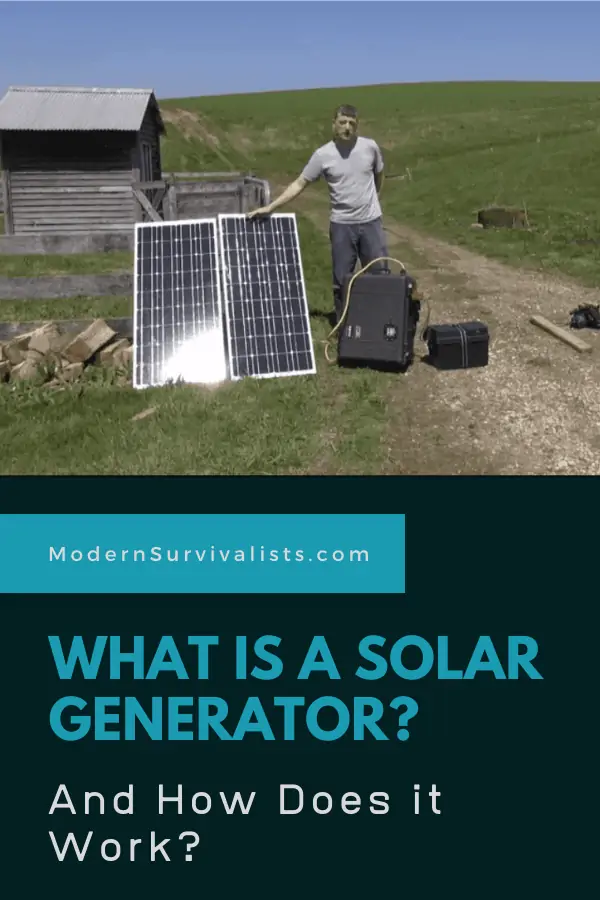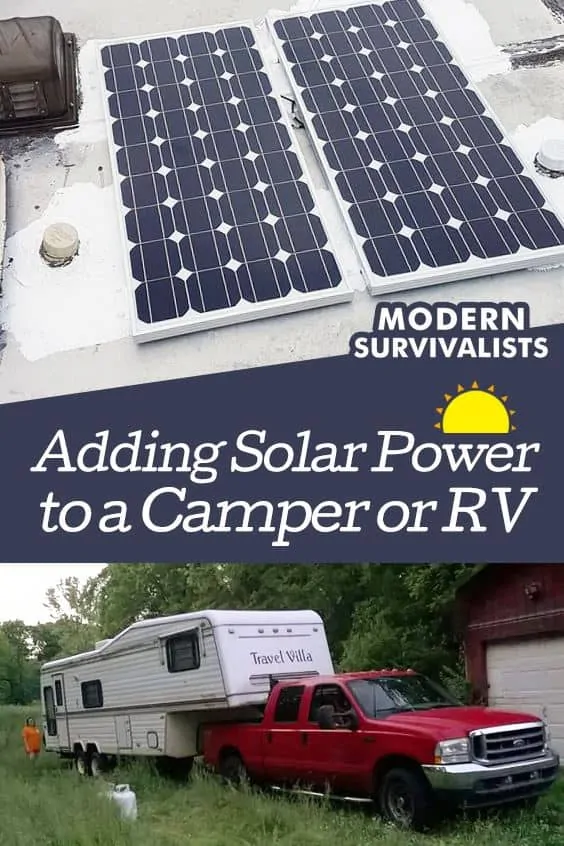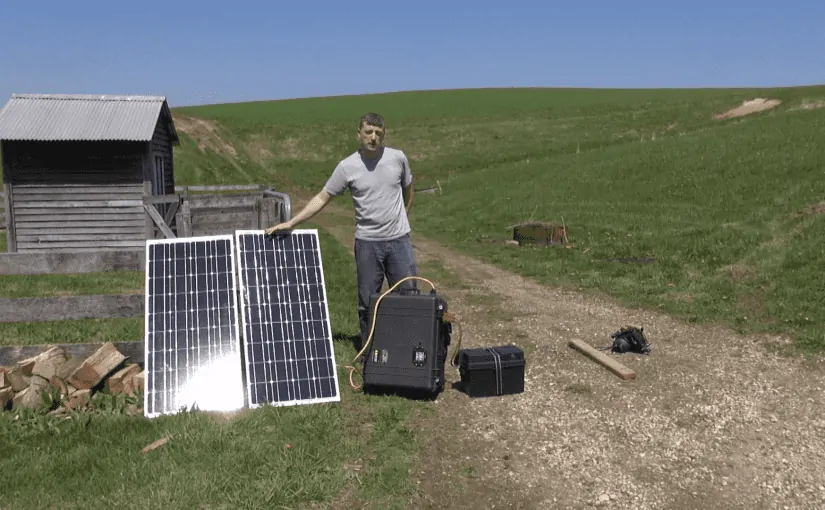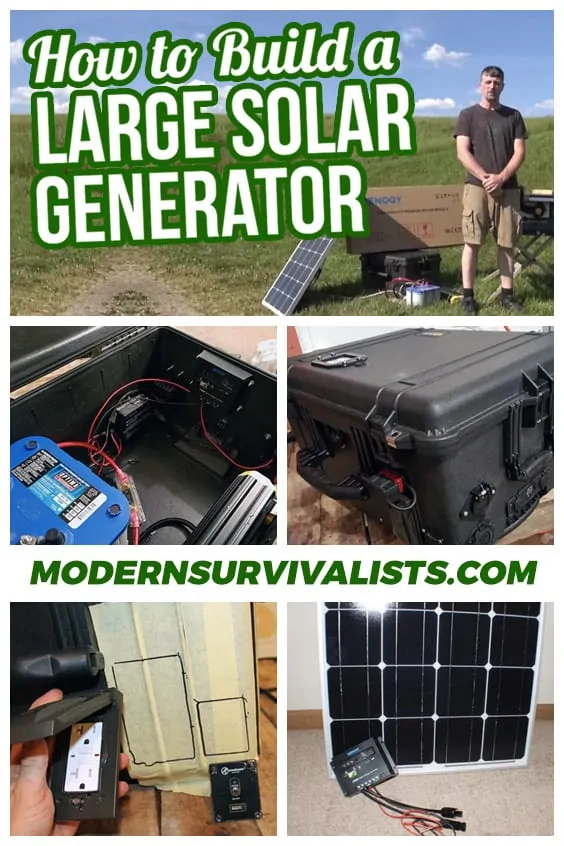A Solar Generator is a term for a device that can convert solar energy from the sun into electrical AC power. Most Solar Generators use one or more solar panels to generate DC electrical power. The DC electricity is then converted to AC electricity with an AC power inverter.
Solar Generators Defined:
Solar Generator is a relatively new term, and definitions can vary. EnergySage defines it as: ” The term solar generator can technically refer to any energy system being powered by the sun. However, people using the term are most often talking about portable solar setups with a specialized battery system attached.”
If you are interested in building your own DIY Solar Generator, you should check out my instructional step by step series for my expandable large solar generator here!

How Does a Solar Generator Work?
There are several main components to a typical solar generator. We will go over each below!
Solar Panels
Solar Panels are the heart of any solar generator. They collect the sunlight and convert it to DC electricity. The amount of power available is based on the size of the panel, and how much sunlight is available at that moment. The power output can vary widely throughout the day due to weather, clouds, shade, etc.
Batteries
Because the available power from the solar panels varies throughout the day, they are often wired to a device called a charge controller that is responsible for taking extra power and charging one or more batteries.
The batteries stores the energy, much like a fuel tank does on a gasoline or diesel generator. The battery bank smooths out the incoming solar power and acts as a reserve power supply for the devices the generator is powering. This allows the solar generator to continue running during cloudy weather, or even overnight in the dark.
The battery pack can also supply larger bursts of power than the solar panels can provide, useful during surges of higher power demands. As long as the solar panels get enough sunlight over time to recharge the batteries – then generator will continue running.
Power For Devices
Most Solar Generators provide several types of power output. Some small solar generators only provide low voltage DC power. 12 volts is a very common power output since it is used extensively in the automotive wold, 12 volt devices are plentiful and inexpensive. This output can be used for automotive style phone / laptop chargers, lights, audio systems, tire infiltrators and more!
Typically there is also USB charging ports available as well. This is most often use to charge cell phones & tablets, but they can be used to charge any USB powered device as well.
Many solar generators also provide 120 volt AC power by using an additional device all an AC Power Inverter. The device will convert the DC battery power to conventional AC power so household devices and appliances can be powered as well.
Pros & Cons of a Solar Powered Generator
There are many advantages to a solar powered generator as compared to a fossil fuel generator. The biggest ones are:
- Silent Operation – Many Solar Powered Generators emit no noise at all. Some units may have a cooling fan that will turn on during operation, but even then it is far quieter than a traditional fuel-powered generator.
- No Emissions – Because the generator is powered by the sun, it does not need to burn fossil fuel, and as a result there are no CO or CO2 emissions.
- Safe to Operate Indoors – Another advantage of the zero CO (Carbon Monoxide) emissions is that the unit can be operated indoors.
- Wide Range of Size – Solar Generators can be purchased or built in a vast range of sizes. This allows for either an extreme portable solar generator for backpacking & camping, or much larger units for backup power, RV’s, and even powering a whole house or off grid cabin.
However, there are some drawbacks as well. Solar Generators will generally cost more than a conventional gas fuel generator of equal power output.
Gas generators can also run at their full power for as long as they have fuel in the tank. Solar Generators on the other hand can have a hard time maintaining enough solar power to keep the battery charged for long and heavy power demand.
What are the Best Solar Generators?
The best solar generator depends on a lot of variables. The best solar generator for backpacking or camping will be relatively small and lightweight. These can be very useful for charging cell phones, laptops, or other electronic power devices in remote places that are otherwise without power.
The folks at ClimateCounts have also put together a list of Top Rated Solar Generators if you would like to look at some more specific models.
Going Big!
For larger power needs you will want a much larger unit. Large solar generators can be used as an emergency solar backup generator, running large power tools, or even powering a whole house or off grid cabin.
Should you Build Your Own DIY Solar Generator?
While some prefer the convenience of buying a manufactured model, there are many reasons you might consider building your own DIY Solar Generator.
- Cost – the cost to build a DIY solar generator from a kit or your own parts is considerable cheaper. You can usually save 50% or more compared to a manufactured model.
- Easy to Repair – By building your own solar generator, if a part fails the component can be easily replaced. With a manufactured model your repair options are much more limited.
- Flexibility – You can custom tailor the options you would like when you build your own solar generator. You can add USB ports, LED utility lights, and many other options. You also can size your main components to your specific needs.
- Fun – It can be a very fun and rewarding project to build a solar generator. Not only will you have a very useful tool when finished, but you will also understand how it works and be able to repair it in the future if needed.

What Solar Generator Topics Did We Miss?
Let me know in the comments below any questions you have that I didn’t already cover. I will do my best to answer them, and plan to have more articles in the future on this topic. Thanks!



speak for you.
comprare patente di Guida
Thanks
I’m build a charger, following your videos. Two thoughts, first I wanted a more solid connection to the extra batteries/jumper cables. So I purchased a set of the connectors that are used to attach welding cables to welding machines. Then I made a short set of adapter cables to the flat plug you used. I spoke to the inverter manufacturer, and they told me I shouldn’t use a ground fault receptacle. What are your thoughts.
I can send a pic if you want of the cable setup.
Hi Mark, thanks for offering your expertise, especially to us beginners. I am “building” my own RV out of a 22 passenger bus and I’d like to put in a solar generator to run a 30 amp system. Can you tell me each component I would need and the size of each component?
Interesting article, you can still add to it:
https://mysolarperks.com/hm-pow-sol-panel
Some clarification is needed in your article. A generator converts mechanical energy to electricity. Solar panels convert light to electricity. Batteries convert chemical energy to electricity.
There is no generation of energy. It’s all about conversion. If we use your definition of a solar generator, a flashlight with a battery charged by a solar panel would be a solar generator because it is charged with a solar panel.
Volts Schmolts. WATTS is what I am wanting to know about. I know the equasion , but it does me no good. I have a room, must have 3000 watts per day, what do I need for produce that.?
hello Mark!
excellent tutorilas. I am learning that staff but tell me please, what is the lowest level of battery that we should never let it to happend? what voltage?
Hi Mark,
This is an awesome tutorial. Just curious if you considered any undervoltage load disconnect device to automatically disconnect the load on the battery before it’s damaged from a deep discharge.
Thanks,
Munir
I like how you mentioned that the sun’s energy can be collected and converted to AC power by the use of a solar generator. My brother is thinking of looking for an emergency survival supplies store because he noticed last week that he didn’t have the necessary equipment to help provide electricity to his home if ever the power went out from a natural disaster. It seems like a good idea for my brother to think about shopping from a reputable supplier for the emergency supplies he needs in case the grid shuts down where he lives.
Realistically a gasoline (diesel if you drive a diesel or natural gas if your home is plumbed for it) generator is the most cost effective option that you have.
We all have a several thousand dollar generator sitting in our drive ways, get a thousand Watt inverter an some good extension cords. Just don’t try to run much over 500 W through the 12 V adaptor, hook it to the battery.
Hi. I installed my first solar-system in 1980, and have installed/helped-install over 1000 systems since then. Point 1: There is NOTHING to it that a half-witted chimpanzee couldn’t figure out. Unfortunately some people go to much trouble to generate unnecessary complications. (The recently-popular term ‘solar-generator’ is a blatant idiocy: solar power is generated by the sun, and NO other source. All we do is harness that energy. Point 2: All that’s required is some solar-panels (I recently bought a 2.5 kw system for AU $230 , including stuff I didn’t need like a grid-connect inverter, and set it up in a difficult spot (trees/neighbours/etc.) in four hours. It’s six years old, which means I’d expect to get at least another 12/15 years production out of it.
Here in Melbourne we get an average 5 hours of useable sunlight per day (year-round) , which means this system will produce 12.5kwh for the foreseeable future. It was on offer because the previous owner wanted to avail himself of the offers being made by the State government for a bigger system. Installation: point panels north (to the sun here in Oz.) at an angle of 37-degrees (Melb. latitude). Connect regulators because I’m not connected to the grid. Bought a (60-amp unit for $76) and connected the regulators to a 720-ah battery bank. ( 12-volt Deep-cycle AMG SLA batteries which I get at a good price, including an unconditional 5-year warranty. I would NEVER pay more than about 30-cents-per-Watt for panels, and something under $2 per ah for top-shelf batteries. (and am NOT impressed by the Li-ion craze at current prices). Also attached to the batteries is a high-tech 50-amp automotive battery-charger and a 4000-watt inverter. (More than I need but couldn’t resist the price!) Getting too long-winded, though there’re other details to consider, as in anything one undertakes. While the above is more than you need to know, you’re welcome to get back to me if you want to get more specifics. (as can anyone else). I can be reached directly here: (because I’m not very good at computerised stuff): [email protected] All the best.
ps. Another furphy akin to the ‘solar-generator’ one is the ‘Modified Sine-Wave Inverter’. There is NO such thing: either you get a ‘pure-sine-wave inverter’ or a ‘square-wave inverter’. There’s a price-difference, but you wouldn’t want to (try to) run sensitive electrical gear from anything but a guaranteed (!) ‘pure-sine-wave’ unit. If you’re only running a toaster/electric jug/old-fashioned frige and the like off AC then square-wave is fine; but it’ll kill a computer/tv/etc. in no time. In any case these days y’can get almost anything (including a small lap-top I have) to run off 12-volts (ie straight off the battery-bank) so an inverter isn’t essential anyway. I use mine mostly to run a spare (240 AC) fridge on a timer and the microwave. Use a 3.7kva remote=start generator for power-tools, washing-machine etc., and occasionally to give the batteries a boost for an hour or so after a few days of overcast skies. You DO learn to adapt automatically one you get into it.
Solar Generators are the best Generators that are small in size and when you are going outside and your Cellphones off due to low battery, then we can use these generators and charge our Mobile Phones and other Electronic devices.
We can easily use Solar generator in Summer Days we know that solar panels take sunlight and convert into DC.
I don’t know if I’m at the right place to ask this, but any help from anyone would be really appreciated. I have a few small solar gadgets and an all season solar oven, things that are super easy to use, but I am totally ignorant when it comes to the panels and cables and wattages and all that tech stuff. In fact, just reading about it makes my eyes start to cross! Here’s the thing, what I want the most is a solar generator strong enough to power my refrigerator and a solar generator strong enough to power my deep freezer. I think those are two of the most vital things to have in an emergency. I am aware of the problems of solar generators not being able to maintain charges long term for large appliances like that, but I’m not worried about that right now (I can buy a few and cycle them). I’ve looked at a number of solar generators – “1200W”, “2400W”, “42000mAh”, “2400 Lithium Portable Solar Generator|2400Wh Power Station with 1000W AC Inverter (2000W Peak)”… etc etc – but I have no idea what any of that means. It might as well be Chinese. And I don’t know if the generator needs to be stronger than the pwer minimum listed on the appliance or if it only has to match. And most of the generators don’t come with the panels and I have no clue what panels to get. I literally need some to say, “You need this, this and this, you plug this into this, then put it in the sun and you’re all set”. PLEASE help!! Thanks a million.
Hi Bell, I understand your confusion, there are lot of different numbers and ways to measure the capacity of a solar generator and how much load it can handle. There are two different main measures – how much power it can provide all at once (usually measured in watts (W) and this will help determine how big of an appliance it can run at all. The second measure is the battery capacity, usually measured in amp hours (AH) and this helps calculate approximately how long it can sustain a particular load. There are lots of factors, and real world conditionals don’t always match exactly, but these two numbers are the easiest to start comparing one unit to another. Take a look at my DIY build (linked up in the article) if you would like to learn how to build your own and you can select the components you want to size the solar generator to your needs.
oops! I just realised (after my other posts: above) that this thread seems to be two years old; so assume you’ve got yourself sorted out by now. However, you (or anyone) are still able to get in touch if you like. Point was (is) that this subject, though you can make ANYTHING as complicated as you like, is actually VERY basic and these days very cheap. My first, used, system in 1980 cost me 13.80 per Watt!; these days y’can get quality new panels for around 40 CENTS per Watt if you hunt around. To be fair, it’s still producing 85% of its rated output on the roof of a friend I gave it to when I moved interstate. As stated: a very basic way to go, and the complications are usually created by people trying to sell you something! Take care.
I like the use of the case for the generator components but do you have any ideas for making the solar panels more portable and secure? If not possible, should I think about permanently mounting them, say in the backyard? How would that be done?
Hi Mike, Yes, the larger solar panels can be pretty bulky. There are some options available on Amazon for flexible & fordable panels that are easier for traveling if you do a lot of that. Since I use mine primarily at home I went with the more traditional roof mount panels as they cost much less per rated watt.